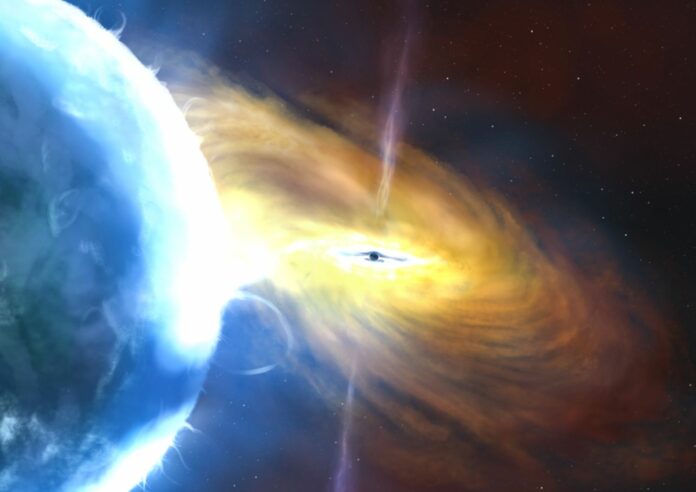A team of astronomers led by the University of Southampton revealed the largest cosmic explosion ever- more than ten times brighter than any known supernova (exploding star) and three times brighter than the brightest tidal disruption event.
The explosion, known as AT2021lwx, is thought to have been caused by a supermassive black hole forcefully disrupting a gigantic cloud of gas that was potentially thousands of times bigger than our sun. A gigantic dusty “doughnut” would surround the black hole, and fragments of the cloud would be sucked up, sending shockwaves through its remnants. Nothing of this scale has ever been seen before, and such phenomena are extremely uncommon.
The explosion lasted over three years, compared to most supernovae which are only visibly bright for a few months. It took place nearly 8 billion light years away, when the universe was around 6 billion years old, and is still being detected by a network of telescopes.
The brightest explosion ever seen was a gamma-ray burst known as GRB 221009A, which was observed by astronomers last year. This was brighter than AT2021lwx, but it was only visible for a small portion of that period, indicating that the total energy released by the AT2021lwx explosion was far higher.
The California-based Zwicky Transient Facility discovered AT2021lwx in 2020, and the Asteroid Terrestrial-impact Last Alert System (ATLAS) in Hawaii later picked it up. These facilities survey the night sky in search of asteroids, comets, and transient objects that abruptly change brightness and signal cosmic occurrences like supernovae. The size of the explosion has not been known up until this point.
Astronomers came upon this by chance as it was signaled by their search algorithm while searching for a type of supernova. The team investigated the object further with several different telescopes: the Neil Gehrels Swift Telescope (a collaboration between NASA, the UK, and Italy), the New Technology Telescope (operated by the European Southern Observatory) in Chile, and the Gran Telescopio Canarias in La Palma, Spain.
The researchers determined the distance to the object by examining the light’s spectrum, breaking it up into distinct wavelengths, and analyzing the spectrum’s various absorption and emission patterns.
After performing calculations to determine the distance to the object and its brightness, the team realized that this is exceptionally bright.
Professor Sebastian Hönig from the University of Southampton, a co-author of the research, said, “The only things in the universe that are as bright as AT2021lwx are quasars – supermassive black holes with a constant flow of gas falling onto them at high velocity.”
Professor Mark Sullivan, also of the University of Southampton and another co-author of the paper, explains: “With a quasar, we see the brightness flickering up and down over time. But looking back over a decade, there was no detection of AT2021lwx; then suddenly it appears with the brightness of the brightest things in the universe, which is unprecedented.”
The team is now looking forward to collecting more data by measuring different wavelengths, including X-rays which could reveal the object’s surface and temperature and what underlying processes are taking place.
Journal Reference:
- P Wiseman, Y Wang et al. Multiwavelength observations of the extraordinary accretion event AT2021lwx. Monthly Notices of the Royal Astronomical Society. DOI: 10.1093/mnras/stad1000
